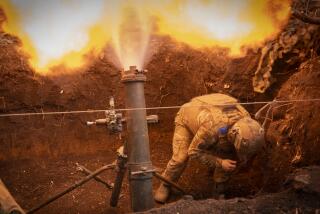NATO Chief Outlines Plans to Modernize Nuclear Arms
- Share via
WASHINGTON — In his first major blueprint for nuclear modernization in Europe, NATO’s chief military officer said Wednesday that he expects to recommend a “fairly significant” reduction in short-range nuclear weapons in exchange for improvements in the alliance’s force of remaining longer-range missiles.
Army Gen. John R. Galvin believes that the North Atlantic Treaty Organization should shift from its dependence on short-range nuclear artillery and toward missiles that could reach targets almost 300 miles away. The U.S.-Soviet treaty on ground-launched medium-range missiles, signed last December, bans missiles with ranges between 300 to 3,400 miles.
But Galvin said further reduction in short-range weapons depends on the modernization of NATO’s nuclear force. The modernization program is expected to provide more effective short-range arms, including a new air-to-ground missile, improved nuclear artillery warheads and a replacement for the aging Lance missile.
That recommendation on short-range weapons is likely to be the focus of NATO’s first nuclear arms requirements study since 1985. It is scheduled to be presented to NATO Secretary General Manfred Woerner by December, said Galvin, who became commander of all U.S. and allied forces in Europe last July.
The issue has already raised controversy in West Germany, where proposals for new nuclear weapons have faced growing popular and political opposition. It also comes as the Soviet Union, whose military is facing changes of its own because of economic restructuring, is trying to coax Western Europeans to reduce or eliminate such short-range nuclear arms.
The proposed withdrawal of older nuclear artillery warheads would be the third major reduction of such weapons in the last eight years. From a high of 7,000 in 1978, the number of short-range, or “tactical,” nuclear warheads deployed in Western Europe has fallen by 2,400 after alliance decisions to withdraw aging or unsafe weapons.
Congressional Curbs
In their place, the Pentagon has sought to build new weapons that it says are safer to handle as well as more efficient and accurate. Galvin said this modernization process has allowed the United States to reduce the overall numbers of nuclear warheads in Europe.
But Congress has placed limits on the development and production of several of those nuclear weapons. In recent years, lawmakers told the Army that it could build no more than 925 of the new artillery warheads it seeks and has blocked the development of a new nuclear warhead for use on a missile designed to replace the Lance.
The West German government also has resisted the deployment of modernized nuclear weapons on its soil.
“The Germans don’t want old ones and they don’t want new ones,” said Robert S. Norris, an analyst with the Washington-based Natural Resources Defense Council, an anti-nuclear research group. The artillery and missiles “are visible systems, and neither the German left nor the right are enthusiastic about them.”
Galvin said, however, that the overall reduction of nuclear warheads in Europe “would help German public opinion” and might persuade Congress to lift restrictions.
More to Read
Sign up for Essential California
The most important California stories and recommendations in your inbox every morning.
You may occasionally receive promotional content from the Los Angeles Times.














